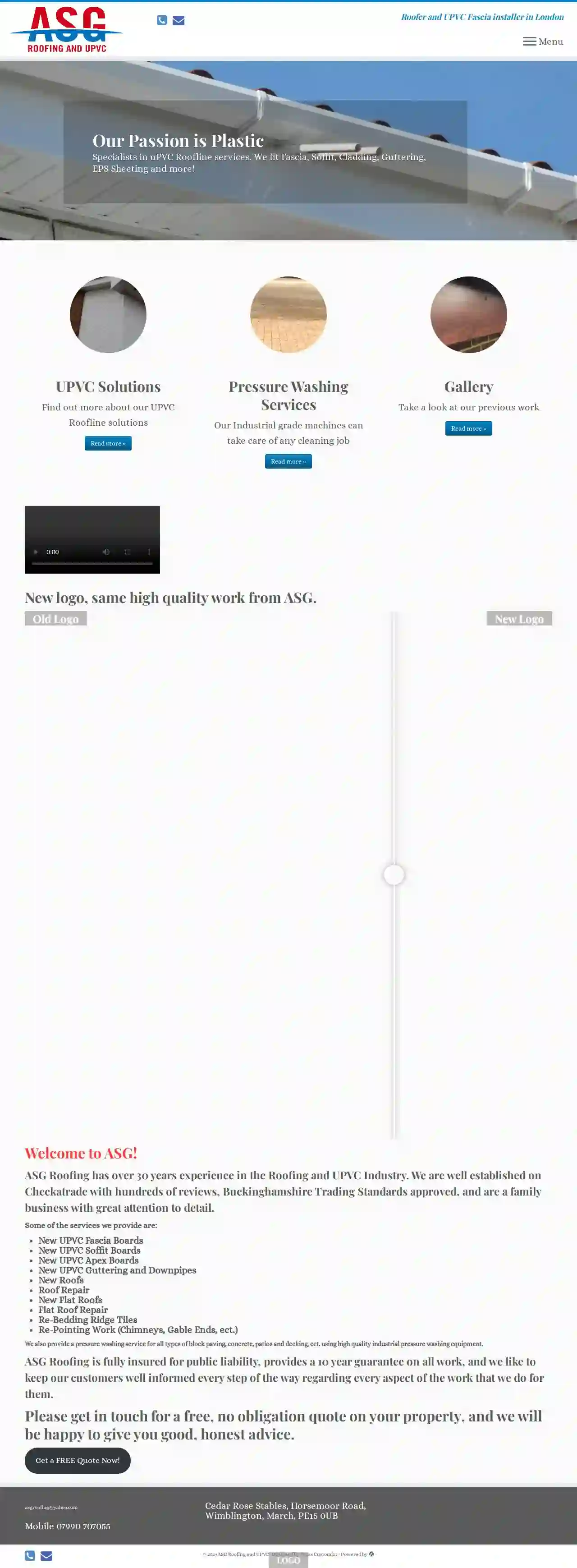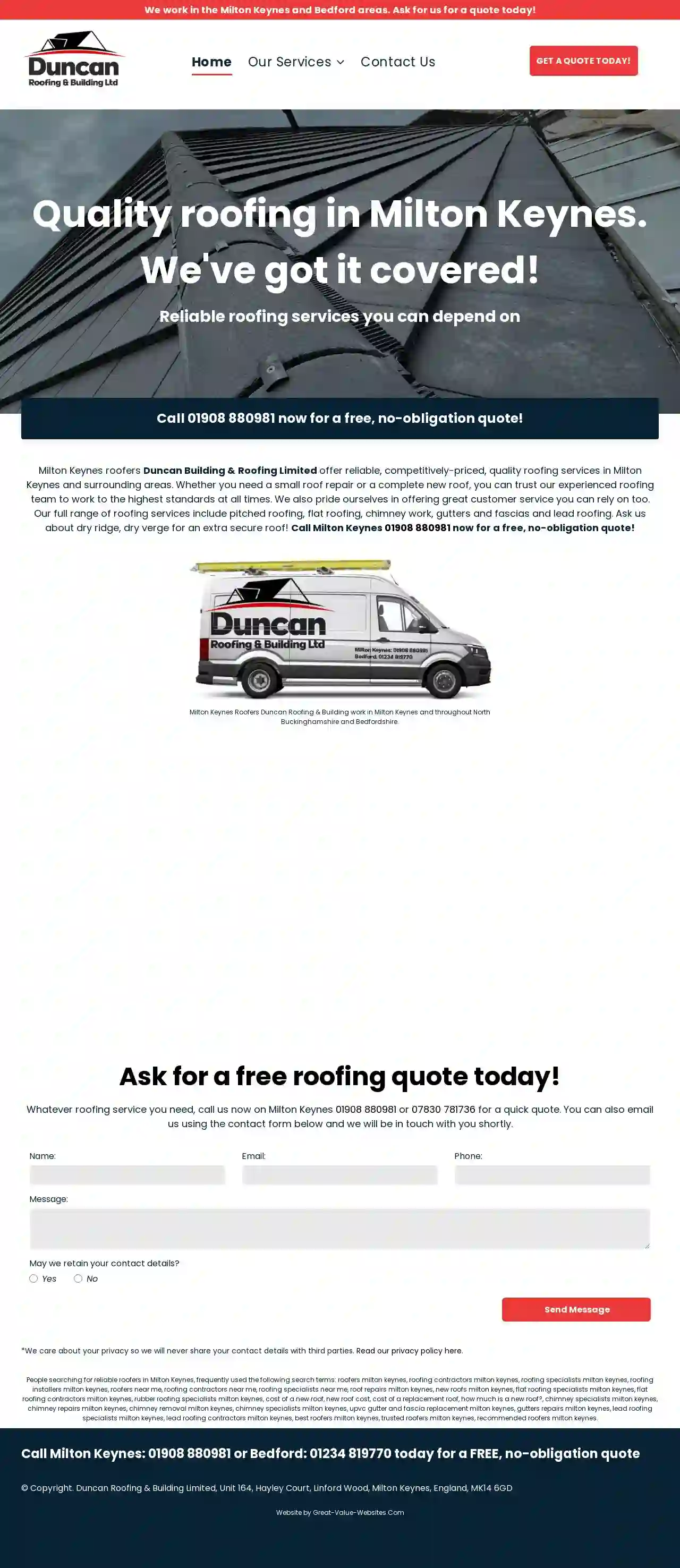Emergency Roof Repair Stoke-on-Trent
Top Roof Repair Emergency in Stoke-on-Trent
Get multiple Emergency Roof Repair quotes for your project today! Compare profiles, reviews, accreditations, portfolio, etc... and choose the best deal.

Quality Roofing
519 reviewsMilton, GBQuality Roofing was formed with the goal to supply what the title says, quality roof installations. With 18 years’ experience in the trade, Kyle Morris, the company director, came to the conclusion that he had all the skills necessary to follow through on this promise in making sure all projects would have the quality finish he had spent his whole working career learning. Kyle’s experience has seen him at the top of his game and at the forefront of the roofing industry in his area and is now putting all his knowledge into this business to provide quality roof installation and quality service. Quality Roofing carry out all aspects of roofing from small repairs to full roof installations and cover a 50 mile radius of Milton Keynes.
- Services
- Why Us?
- Our Team
- Gallery
Get Quote
Roofer in Milton Keynes, Leighton Buzzard & Bletchley - 1st Call Roofing
34 reviewsGBForthright Roofing is a leading roofing company serving Milton Keynes, Leighton Buzzard, and Newport Pagnell. We pride ourselves on providing top-quality roofing services with a guarantee, free no-obligation quotations, and a commitment to using the best materials. Our team of experienced roofers specializes in all aspects of roofing, from new roofs and re-roofing to EPDM rubber roofing, chimney repairs, tiled conservatory roofing, flat roofing, fascia, soffit, and guttering. We also offer emergency roof repairs and bespoke roofing solutions. At Forthright Roofing, we believe in a transparent and customer-focused approach. We work closely with our clients to understand their needs and provide tailored solutions that meet their specific requirements. Our 3-step process ensures a smooth and efficient project, from initial inspection and planning to completion. We are dedicated to delivering exceptional customer service and exceeding expectations. Our team is friendly, professional, and always ready to answer your questions. We are committed to providing a hassle-free experience from start to finish. Choose Forthright Roofing for all your roofing needs. Contact us today for a free quote and let us help you protect your home or business.
- Services
- Why Us?
- Accreditations
- Our Team
- Testimonials
- Gallery
Get Quote
All Pro Roofing And Guttering Ltd
53 reviewsChallenge House Sherwood Drive, Bletchley, MK36DP, GBAll Pro Roofing And Guttering Ltd is a reputable roofing company with a team of qualified roofers boasting over 30 years of experience in the trade. We understand the importance of quality roofing services and honesty, especially given the negative publicity surrounding rogue traders in the industry. Our goal is to stand out from the competition by providing exceptional service and transparent practices. We offer a wide range of roofing services for domestic properties of all types, sizes, and budgets, ensuring every job is completed to the highest standards.
- Services
- Why Us?
- Gallery
Get Quote
ASG Roofing and UPVC
51 reviewsCedar Rose Stables, Horsemoor Road, Wimblington, March, PE15 0UB, GBASG Roofing has over 30 years experience in the Roofing and UPVC Industry. We are well established on Checkatrade with hundreds of reviews, Buckinghamshire Trading Standards approved, and are a family business with great attention to detail. Some of the services we provide are: New UPVC Fascia Boards New UPVC Soffit Boards New UPVC Apex Boards New UPVC Guttering and Downpipes New Roofs Roof Repair New Flat Roofs Flat Roof Repair Re-Bedding Ridge Tiles Re-Pointing Work (Chimneys, Gable Ends, ect.) We also provide a pressure washing service for all types of block paving, concrete, patios and decking, ect. using high quality industrial pressure washing equipment. ASG Roofing is fully insured for public liability, provides a 10 year guarantee on all work, and we like to keep our customers well informed every step of the way regarding every aspect of the work that we do for them. Please get in touch for a free, no obligation quote on your property, and we will be happy to give you good, honest advice.
- Services
- Why Us?
- Accreditations
- Gallery
Get Quote
Weathershield Roofing & Decorating
54 reviews31 Southhall, Southhall, UB1 2BW, GBWELCOME TO WEATHERSHIELD ROOFING & DECORATING Weathershield Roofing & Decorating is a Family Run Roofing company Based in Southhall. We have an expert team available. We offer excellent New Roof, Flat Roof, Roof Repairs, Chimneys Rebuilt, Roof Cleaning, Guttering, Fascias & Soffits and much more to clients in the local area. Most of our work comes from recommendations, this shows the level of trust our customers have in us. Whatever style property you have, our experienced team can handle any roofing project small or large to compliment your home and its surroundings, for you and your family to enjoy for many years to come.
- Services
- Why Us?
- Testimonials
- Gallery
Get Quote
E stanley and son roofing
514 reviews17 Oakhaven Park, Radclive Road Gawcott, Gawcott, MK18 4JB, GBBuckinghamshire Roofing & Roof Repairs is a leading roofing company serving clients throughout Buckinghamshire and the surrounding areas. We pride ourselves on providing a 5-star roofing service to both commercial and residential clients. We invest heavily in our equipment, staff, and systems to ensure we can deliver the highest quality workmanship for every project, big or small. Our team of expert roofers are all in-house trained and vetted to the highest standards, and we never sub-contract any work. We use only the best local suppliers with the highest quality materials, and we're committed to providing transparent pricing and a hassle-free experience for our clients. We understand that your roof is a vital part of your property, and we're dedicated to providing a reliable and trustworthy service that you can count on.
- Services
- Why Us?
- Our Team
- Testimonials
- Gallery
Get Quote
Duncan Roofing & Building Limited
4.69 reviewsUnit 164, Hayley Court, Linford Wood, Milton Keynes, MK14 6GD, GBWe work in the Milton Keynes and Bedford areas. Ask for us for a quote today! Quality roofing in Milton Keynes. We've got it covered! Reliable roofing services you can depend on. Call 01908 880981 now for a free, no-obligation quote! Milton Keynes roofers Duncan Building & Roofing Limited offer reliable, competitively-priced, quality roofing services in Milton Keynes and surrounding areas. Whether you need a small roof repair or a complete new roof, you can trust our experienced roofing team to work to the highest standards at all times. We also pride ourselves in offering great customer service you can rely on too. Our full range of roofing services include pitched roofing, flat roofing, chimney work, gutters and fascias and lead roofing. Ask us about dry ridge, dry verge for an extra secure roof! Call Milton Keynes 01908 880981 now for a free, no-obligation quote! Milton Keynes Roofers Duncan Roofing & Building work in Milton Keynes and throughout North Buckinghamshire and Bedfordshire.
- Services
- Why Us?
- Gallery
Get Quote
M Foster Roofing
57 reviews9 Bicester Road, Verna House, Aylesbury, HD19 9AG, GBM Foster Roofing provides professional roofing and construction services to clients across Bucks and the surrounding areas. We specialise in domestic roof replacements, roof repairs, EPDM flat roofing, roof lanterns, extensions and orangeries. Our team of expert roofers ensure that our customers receive a friendly, reliable and efficient service, from first contact through to project completion and beyond. We pride ourselves in the quality and finish for all roofing and construction works.Our customers benefit from our years of experience and vast knowledge.
- Services
- Why Us?
- Accreditations
- Testimonials
- Gallery
Get Quote
M & N Roofing
55 reviewsMilton Keynes, 123 Main St, MK1 1AA, GBM&N Roofing Ltd is a family-run business with more than 30 years of experience in roofing and roof installations, you can trust us to provide quality roofing services tailored to your requirements. We have been providing expert roof services in Milton Keynes, Bedford, Luton & Aylesbury and surrounding areas for the domestic and commercial sectors for many years. Perhaps you need new soffits or fascias or your roof is leaking and have been putting it off, well there is no time like the present to get your quote for your new roof or roof repair in Milton Keynes. From a complete new roof to new uPVC fascias and guttering, you can expect a professional service from your local roofing specialists. To discuss your requirements, please don’t hesitate to get in touch today; we’ll be happy to help.
- Services
- Why Us?
- Gallery
Get Quote
MK Ball Roofing & Property
123 Main Street, Baltimore, 21230, GBMD Roofing & Maintenance is a family-owned and operated business serving the greater Maryland area. We are dedicated to providing high-quality roofing and maintenance services to both residential and commercial clients. With years of experience in the industry, our team of skilled professionals is equipped to handle all your roofing needs, from minor repairs to complete roof replacements. We pride ourselves on our commitment to customer satisfaction, using only the finest materials and employing the latest techniques to ensure lasting results. Whether you need a new roof, repairs, or regular maintenance, MD Roofing & Maintenance is your trusted partner for all your roofing solutions.
- Services
- Why Us?
Get Quote
Over 12,314+ Roofing Businesses onboarded
Our roofing pros operate in Stoke-on-Trent & surroundings!
Roofyng.co.uk has curated and vetted Top Roofers in Stoke-on-Trent. Find the most reliable business today.
Emergency Roof Repair FAQs
- Ensure Proper Ventilation: Improve attic ventilation by installing soffit vents, ridge vents, or other ventilation systems to allow for better airflow and prevent moisture buildup.
- Check for Plumbing Leaks: Inspect plumbing pipes and fixtures in your attic for leaks, as they can contribute to moisture problems.
- Insulate Properly: Make sure your attic is adequately insulated to prevent warm air from escaping from your living spaces. This helps maintain a consistent temperature and minimize condensation.
- Use a Dehumidifier: If condensation is a recurring issue, consider using a dehumidifier in your attic to reduce moisture levels.
- Your roof has only one existing layer of shingles.
- The roof deck is in good condition.
- The damage is primarily cosmetic and doesn't involve significant structural issues.
- Ensure Safety: Prioritize safety and do not attempt to access the damaged roof or make any repairs yourself. Wait for professional assistance.
- Contact Your Insurance Company: Report the damage to your insurance company as soon as possible. They will guide you through the claims process.
- Contact a Roofing Contractor: Engage a reputable roofing contractor specializing in fire-damaged roofs to assess the extent of the damage and provide recommendations for repair or replacement.
- Secure the Property: Take necessary measures to secure your property, such as boarding up windows and doors, to prevent further damage or theft.
How much does an emergency roof repair cost in the UK?
What should I do if my roof is leaking but it's not raining?
How do I know if my roof needs to be re-roofed?
What should I do if my roof is damaged in a fire?
How much does an emergency roof repair cost in the UK?
What should I do if my roof is leaking but it's not raining?
- Ensure Proper Ventilation: Improve attic ventilation by installing soffit vents, ridge vents, or other ventilation systems to allow for better airflow and prevent moisture buildup.
- Check for Plumbing Leaks: Inspect plumbing pipes and fixtures in your attic for leaks, as they can contribute to moisture problems.
- Insulate Properly: Make sure your attic is adequately insulated to prevent warm air from escaping from your living spaces. This helps maintain a consistent temperature and minimize condensation.
- Use a Dehumidifier: If condensation is a recurring issue, consider using a dehumidifier in your attic to reduce moisture levels.
How do I know if my roof needs to be re-roofed?
- Your roof has only one existing layer of shingles.
- The roof deck is in good condition.
- The damage is primarily cosmetic and doesn't involve significant structural issues.
What should I do if my roof is damaged in a fire?
- Ensure Safety: Prioritize safety and do not attempt to access the damaged roof or make any repairs yourself. Wait for professional assistance.
- Contact Your Insurance Company: Report the damage to your insurance company as soon as possible. They will guide you through the claims process.
- Contact a Roofing Contractor: Engage a reputable roofing contractor specializing in fire-damaged roofs to assess the extent of the damage and provide recommendations for repair or replacement.
- Secure the Property: Take necessary measures to secure your property, such as boarding up windows and doors, to prevent further damage or theft.